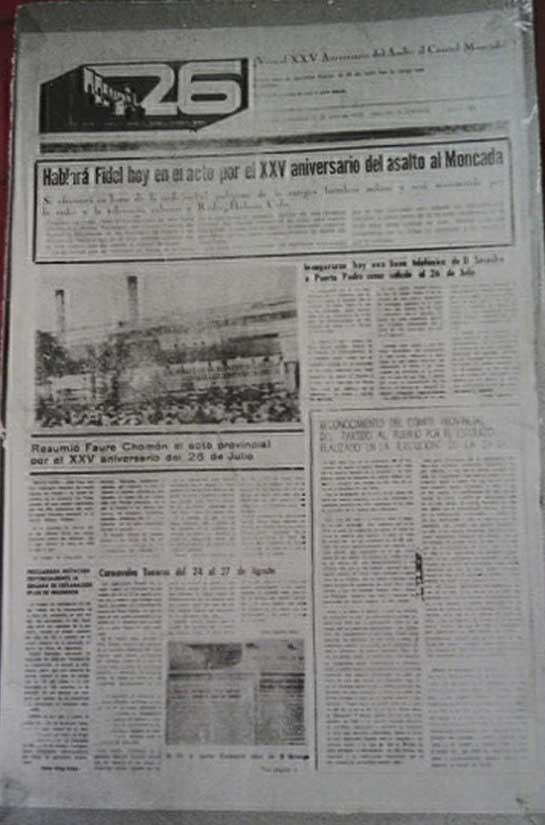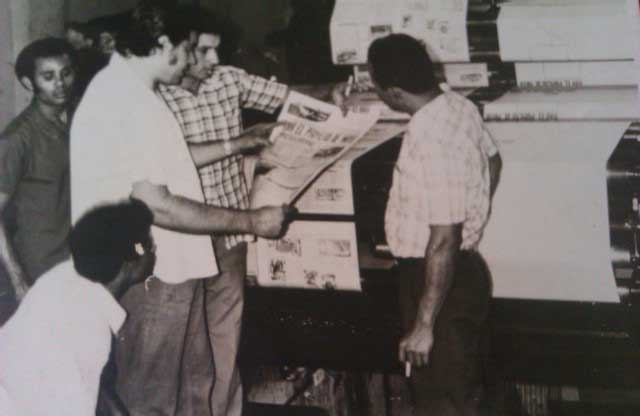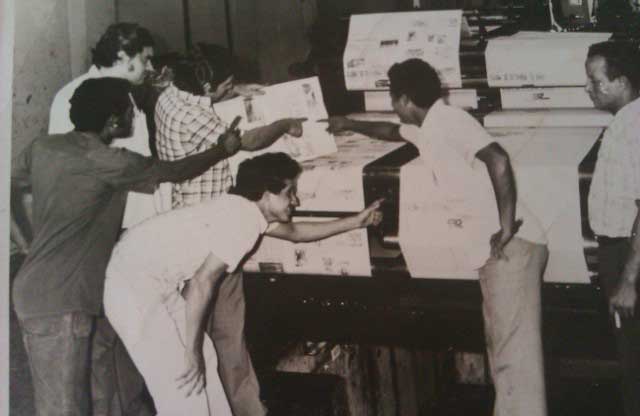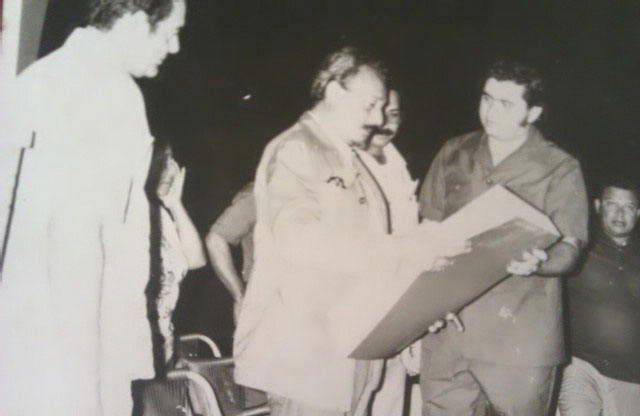|
|
To the memory of those who are no longer here. To all the founders.
Another new July makes paths and awakens memories. The essences are the same, although nothing is the same. Well... the sleepless nights are sweet karma for those who one day, for their reasons and paths, decided to carry a pen at the ready and a diary under their arm, in their wallet, briefcase, or rucksack. In those early years, we almost always carried it in our hands. It was the talisman.
 26's front page, that Wednesday, July 26, 1978. |
This Santa Ana morning we are still in ecstasy, despite the 45 crosses that make up the newspaper's birthday chain, which has a very strong number in its head: 26. A story that, however much we repeat it, does not lose its preponderance nor does it cease to be a novelty for most of our fellow citizens.
Countless nights with their dawns have come and gone since then for the team that founded the historic daily newspaper of the people from Las Tunas with lead letters and words, in a 90-character linotype.
The truth is that nobody slept on the eve of that 26 July. They were not partying for the arrival of the date that changed the course of the country and brought the dawn of January 1959 closer. They were expectant, with their eyes on the front-page editorial, the selection of the best photos, the news, and the last-minute changes.
It was impossible to leave the editorial office at 157 Colón Street, between Julián Santana and Francisco Vega, the very heart of the city, right where Radio Victoria's studios are today. The "sticker" was for not only reporters, editors, photographers, format designers, typographers, and managers. Everyone had to leaf through that hot paper that would eventually come off the old press, a noisy iron mass with more than a century of life called Duplex.
Nobody left. The coffee coming out of the pantry-dining room pretended to be ephemeral, just like the cigars. Time and doubt embraced each other many times in the spine of that group of "journalists" who accepted the challenge of loving "news production and capsular lead" without any experience and only a few essential training courses.
Success depended on the workshop. There were the final words and the value of the 37 uninterrupted hours of sleeplessness they had. The heat was unbearable, the noise worse. Every second brought them closer to the glorious name and the commitment to the Party and the people. They could not fail.
The ground floor of the building was practically a warehouse of ink and fragmented papers as if smeared with tar. Everyone lost count of the number of times they went down there to find out what was happening with the final part of the titanic process that would lead them to victory. The relentless determination of Eduardo Infante, the most magical mechanic in the world that 26 knew, and the agitation of Roberto Leyva, the daring and optimistic head of the printing area, was luck and hope; calm and despair.
The "lions", the brothers Alcides and Melquiades Labrada, put their skills as operators to the maximum and did not let the old Duplex get away with it. Between hot flushes, with sleep and tiredness tied to the roof, the princely specimens of an event that smelled like a legend begin to fall. Las Tunas greets the 25th anniversary of the national heroic deed with a printed newspaper.
 Roberto Leyva, on the right, waits for the Infante Reyes brothers, along with the operators and a reporter, to check the newspaper. Leaning in the center is Jesús Marrero, who was an important source of help in the workshop. |
And hours later, those original "sons" went to the school town of 26 de Julio, in Santiago de Cuba. The late Commander Faure Chomón Mediavilla was waiting for them at the central ceremony to present Fidel with a sample of the first newspaper of the Revolution in Las Tunas. To Faure, with his support, the people of Las Tunas owe the circulation of their main mouthpiece, José Infante Reyes, who is no longer with us and was its founding director, told us in an interview we conducted on the occasion of the 40th birthday of such an endearing and transcendental event.
Months ago, in May, the study of the project began, with the necessary analyses and the fitting out of the premises, where television sets and refrigeration equipment were repaired. In pre-revolutionary times, the La Bomba hardware store, owned by a family of Polish origin, was located there.
On Tuesday 25th, Justo Peña (deceased), the only linotypes at the long-awaited newspaper, worked non-stop for 24 hours to stop in lead the journalistic materials, in eight-point letters for two pages. Abel Fernández and Omelio González did it by hand, letter by letter, and Reybel Torres and Ricardo González were in charge of the plates.
 Tuesday, before DAY ONE, was made up of intensely vigilant and tense hours. |
This first edition had a standard size: 120 pages high and 79 wide, with five columns of 15 and four pages. Omar Pérez and Manuel Tamayo, who belonged to the Propaganda Unit, closely linked to the publisher, gave birth to this "pioneer" of the new province, and because of the instability of the rotary press and the rush to Santiago de Cuba, helped with the first print run. Three thousand copies were printed, which were folded by hand and packed by the reporters and other workers.
Amidst the red and black flags flying around the town and the holiday commemorating one of the most remarkable days in history, on the newsstands, hundreds of reading hands were fondling their newsprint with excited amazement. There was already an informative proclamation in the land of Cucalambe, a milestone for present and future cultural development.
In the months of 1978, with similar effort and verbs and gerunds related to adjusting, coupling, mending, persevering, working, and innovating, the strengths of the unforgettable morning of Santa Ana grew; as did the journalistic guild, the workshop, and service staff, and the editorial goals of a creative site that is celebrating its 45th anniversary with the same people, active and retired, or in that dimension where these evocations will always be rewarded.
The birth of 26 was a legitimate birth of faith and love, just as it is now with the Friday print version or the daily digital edition and its profiles on the Internet. The reporters who came later are already grizzled over the road of challenges, falls, and rises. They honor the scoop of light that shook the dawn of that rebellious Wednesday in 1978. For those who departed and those who are, WE CONTINUE.






